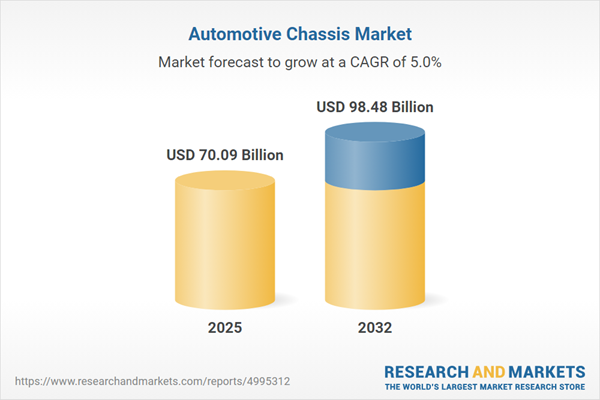Speak directly to the analyst to clarify any post sales queries you may have.
The global automotive chassis market is evolving rapidly as new technologies, regulatory pressures, and consumer expectations reshape platform design and manufacturing strategies throughout the industry.
Market Snapshot: Automotive Chassis Market Size and Growth Outlook
The automotive chassis market grew from USD 66.79 billion in 2024 to USD 70.09 billion in 2025 and is projected to reach USD 98.48 billion by 2032, reflecting a CAGR of 4.97%. This growth is fueled by continued advancements in materials science, shifting drivetrain architectures, and an increasingly complex regulatory environment. Senior leaders face both challenges and opportunities as chassis manufacturers adapt to new propulsion needs and evolving vehicle safety standards.
Scope & Segmentation of the Automotive Chassis Market
This report provides detailed analysis and market forecasts by examining major segments, materials, technologies, and regions.
- Material Types:
- Cast Aluminum
- Extruded Aluminum
- Carbon Fiber Reinforced Polymer
- Glass Fiber Reinforced Polymer
- Cold Rolled Steel
- High Strength Steel
- Frame Types:
- Backbone Chassis
- Ladder Frame
- Monocoque
- Space Frame
- Drive Types:
- Four Wheel Drive
- Two Wheel Drive
- Vehicle Types:
- Buses
- Trucks
- Pickups
- Vans
- Hatchbacks
- Sedans
- SUVs
- Distribution Channels:
- Aftermarket
- Original Equipment Manufacturer
- Regional Coverage:
- United States
- Canada
- Mexico
- Brazil
- Argentina
- Chile
- Colombia
- Peru
- United Kingdom
- Germany
- France
- Russia
- Italy
- Spain
- Netherlands
- Sweden
- Poland
- Switzerland
- United Arab Emirates
- Saudi Arabia
- Qatar
- Turkey
- Israel
- South Africa
- Nigeria
- Egypt
- Kenya
- China
- India
- Japan
- Australia
- South Korea
- Indonesia
- Thailand
- Malaysia
- Singapore
- Taiwan
- Key Companies Profiled:
- ZF Friedrichshafen AG
- Robert Bosch GmbH
- Continental AG
- JTEKT CORPORATION
- Automotive IQ
- ThyssenKrupp AG
- Magna International Inc.
- E&E Manufacturing Company
- SM Auto Engineering Pvt. Ltd.
- ArcelorMittal
- REE Automotive Ltd.
Key Takeaways for Senior Decision-Makers
- Material innovations, especially in recyclable composites and advanced steel grades, are supporting regulatory compliance and enabling chassis light-weighting without compromising durability or safety.
- Electrification and autonomous vehicle trends are pushing chassis design towards modular, multi-energy platforms capable of integrating battery packs and advanced electronic systems.
- Distributed supply chains and tactical localization efforts are mitigating tariff and trade policy impacts, with North America and Asia-Pacific emerging as centers of chassis production and assembly adaptation.
- The combination of traditional steel with high-value composite materials is enabling OEMs to optimize performance across both mass-market and premium vehicle segments.
- Digital engineering, including virtual validation and digital twin platforms, is reducing development risks and accelerating new chassis platform launches.
Tariff Impact: Navigating US Trade Measures
Recent introduction of US tariffs on steel and aluminum has driven significant changes in sourcing and production strategies. OEMs and suppliers are increasing domestic investments and forming new alliances with regional processors. Material substitution and multi-sourcing are key tactics to counter cost increases and maintain delivery timelines, while contract negotiations have intensified, factoring in the total landed cost. Collaborative ventures and local production are becoming central themes for maintaining market access despite regulatory shifts.
Methodology & Data Sources
This report utilizes a robust hybrid research methodology, combining in-depth primary interviews with OEMs, suppliers, and material leaders, alongside secondary sources including regulatory filings, patents, and industry publications. Data triangulation and peer reviews ensure all insights are fully validated and provide a fact-based view of the global automotive chassis market.
Why This Report Matters for Chassis Market Leadership
- Senior executives gain clear perspectives on evolving technology priorities, regulatory influences, and localization strategies necessary for market competitiveness.
- Practical recommendations equip leaders to align innovation, supply chain resilience, and digital transformation for sustainable growth amid disruptive change.
- Comprehensive coverage allows strategic benchmarking against leading players and emerging trends in every global region.
Conclusion
The automotive chassis market is at a pivotal point, shaped by advancements in materials, growing digitalization, and a shifting trade landscape. Organizations that prioritize adaptability, collaboration, and sustainable innovation will be well-positioned for ongoing growth.
Additional Product Information:
- Purchase of this report includes 1 year online access with quarterly updates.
- This report can be updated on request. Please contact our Customer Experience team using the Ask a Question widget on our website.
Table of Contents
3. Executive Summary
4. Market Overview
7. Cumulative Impact of Artificial Intelligence 2025
Companies Mentioned
The companies profiled in this Automotive Chassis market report include:- ZF Friedrichshafen AG
- Robert Bosch GmbH
- Continental AG
- JTEKT CORPORATION
- Automotive IQ,
- ThyssenKrupp AG
- Magna International Inc.
- E&E Manufacturing Company
- SM Auto Engineering Pvt. Ltd.
- ArcelorMittal
- REE Automotive Ltd.
Table Information
| Report Attribute | Details |
|---|---|
| No. of Pages | 198 |
| Published | October 2025 |
| Forecast Period | 2025 - 2032 |
| Estimated Market Value ( USD | $ 70.09 Billion |
| Forecasted Market Value ( USD | $ 98.48 Billion |
| Compound Annual Growth Rate | 4.9% |
| Regions Covered | Global |
| No. of Companies Mentioned | 12 |









